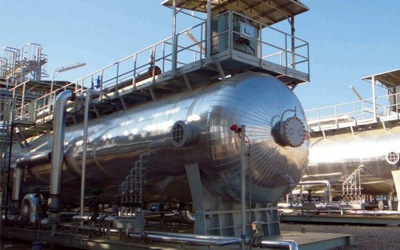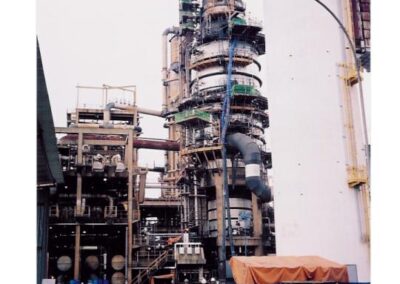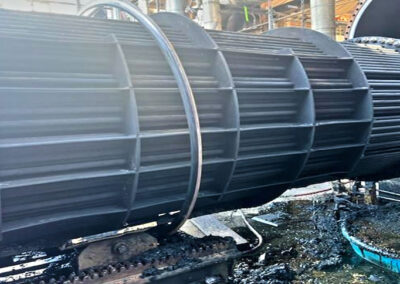Part 7
As we have spoken about decontamination of the crude distillation unit we have discussed tank cleaning operations, how to address troublesome desalters and general degassing issues. Throughout these talks, there has been a common theme in the background. And, what is that? Often, the refiner is plagued with fouling from heavy organic deposits, like waxes and asphaltenes and decontaminating asphaltenes becomes critical to the operation. Why is this so?
A crude oil, at atmospheric pressure and ambient temperature, has three main constituents:
- Oils (saturates and aromatics)
- Resins and
- Asphaltenes
The global market is shifting toward heavier, more acidic, higher sulfur content crude oil as the supplies of light, low-sulfur crudes are depleted. The concentration of asphaltene in a very low-density crude oil may be only a fraction of 1% while the concentration in a dense bitumen can be over 20% of the total mass. The low solubility of the asphaltene fraction makes it very important in production and processing of petroleum. Unlike resins, asphaltenes contain highly polar species that tend to associate. As a result, the interactions of asphaltenes with their environment are very complex. For example, asphaltene precipitation or deposition can occur in wellbores, pipelines and surface equipment. The undesirable result is a reduction in well productivity, limiting fluid flow and impacts heat transfer in processing operations. Every oil producer and petroleum refiner that handles heavy crude oils understands these problems all too well.
The main factors that promote precipitation are pressure, temperature and composition variations. Asphaltene precipitation is often observed in light crude oils that contain very low asphaltene content. This is because light crudes contain large amounts of light alkanes in which asphaltenes have limited solubility. Heavy oils, which are usually rich in asphaltenes, contain large amounts of intermediate components that are good asphaltene solvents. However, the refining of heavy oils in downstream operations is very challenging because it can lead to coking, fouling and catalyst deactivation during processing or upgrading, as high temperatures and vacuum conditions are required. In subsurface formations, the adsorption of asphaltenes on mineral rocks can lead to formation damage. In short, asphaltenes impact virtually all aspects of utilization of crude petroleum and despite this importance, asphaltenes have not been well understood.
What do asphaltenes look like?
Well, these are a broad mixture of components rich in ring groups, not straight chains, with a size of ring groups ranging from 1-7 rings in a single cluster. Bridges between these clusters give larger molecules and extreme diversity of composition. These polydisperse molecules consist mostly of polynuclear aromatics (PNA) with different proportions of aliphatic and alicyclic structures and a few atoms of oxygen, nitrogen, and sulfur and heavy metals such as vanadium and nickel. Of note, many polynuclear aromatics, also known as PAH’s (polyaromatic hydrocarbons), are some of the most carcinogenic compounds known to man. Heavy resins and waxes typically co-precipitate with the asphaltenes making for a complex mixture of compounds in a deposit.

An example of various asphaltene compounds is depicted above.
A variety of experimental measurements show that asphaltene compounds aggregate to form clusters or particles over a wide range of concentration and temperature, both in petroleum and in solvents such as toluene. Several molecular interactions can contribute to the formation of very stable aggregates or clusters of molecules:
- Acid-base interactions
- Hydrogen bonding
- Coordination complexes with metals such as vanadium
- Association with hydrophobic pockets of cycloalkyl groups and non-polar materials
- Aromatic stacking
Each of these interactions is relatively weak by themselves, but like Velcro, the combination of multiple weak links gives a strongly associated structure. We encounter asphaltenes that are taffy-like and are highly adhesive to shiny, black rocks.
What does decontaminating asphaltenes mean in a refinery?
Asphaltene precipitation in a storage tank reduces storage capacity and becomes nearly impossible to remove without expensive, aggravatingly difficult operations. In piping and heat exchangers, the asphaltenes agglomerate on the walls of the equipment, severely reducing fluid flow and, in the case of heat exchangers, cost the refiner much more money to heat the crude to the desired operating temperatures. Often piping must be cut-out and replaced while exchanger bundles are cut-out of shells and mechanically cleaned with lost time, great waste and large mechanical cost to the owner. As asphaltenes have an affinity for preferential precipitation to certain types of surfaces such as carbon and stainless steels, furnaces become fouled with asphaltenes which eventually become coke deposits. Moreover, this does not address the fouling present in atmospheric and vacuum distillation towers and many other columns and associated equipment in FCC’s, Cokers, Hydrocrackers, etc.
Luckily technology has progressed to the point of offering a variety of chemical solutions decontaminating asphaltenes. Asphaltene solvents, asphaltene inhibitors, and dispersants are available for use in removing, preventing and suspending asphaltenes. Unfortunately, most refinery locations do not use these types of materials. Not because they would not be effective. On the contrary, the refiner either simply has not been introduced to the technologies or unwilling to try newer products. A word of caution, not all that glitters is gold. This is to say that not all products marketed for asphaltene control are very effective. Be selective.
A well-chosen chemical product designed for decontaminating asphaltenes can dissolve existing deposits while maintaining the asphaltene molecules in dispersion for extended times. The value of stable asphaltene control using dispersion rests with re-introduction of the cleaning fluids into the refinery process without re-deposition of the asphalt. Additionally, the technology exists to function as an anti-foulant. The anti-foulant products will prevent asphalt fouling allowing for prolonged equipment run times.
On the turnaround maintenance side of refinery operations, the introduction of an asphaltene dispersant to the crude unit cool-down liquid can eliminate asphaltene fouling in pre-heat exchangers, tower bottoms, and piping without requiring additional man-hours for mechanical cleaning. This process is particularly attractive for removing heavy deposits that are typically found in the atmospheric and vacuum towers and regularly require man-hours for physical removal prior to maintenance hot work. What a great idea. Inject a chemical into the cool-down fluid and clean-up your exchangers, piping and towers of heavy deposits without any additional time being required. Reduce the outage time by many, many hours. Yes, it is possible.



